This was published 10 months ago
The Magic Ticket part two: A free pass to the best moments in Sydney sporting history
Willy Wonka gave out Golden Tickets, but we’ve handed out Magic Tickets to take journalists to any sporting event ever held in Sydney.
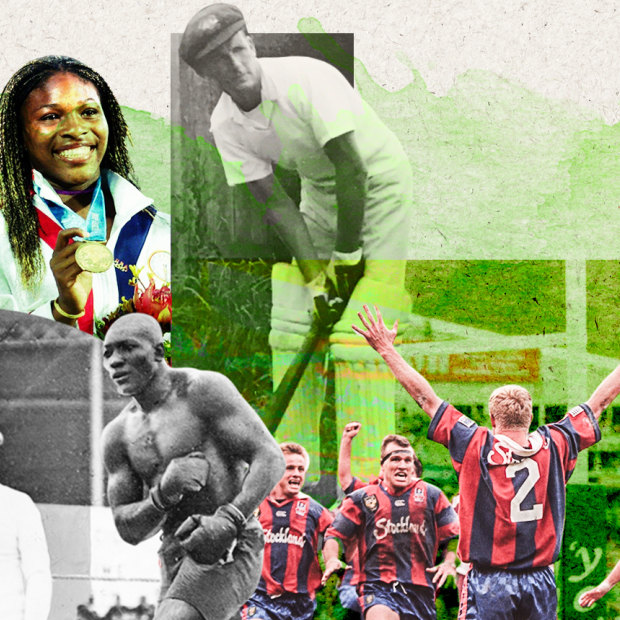
Great moments in Sydney sport from Johnson v Burns to the Williams sisters.Credit: Getty/Jamie Brown
The game that saved rugby league, the Australian daredevil who toppled Evel Knievel or the family bloodlines that run all the way back to when two of racing’s great rivals clashed four times in four days at Randwick.
We gave staff a Magic Ticket which enabled them to attend any sporting event in the history of Sydney. We ran the first batch of selections on Boxing Day, here are the next set of picks.
Men’s long jump final at the Sydney 2000 Olympics
Where: Stadium Australia
When: September 28, 2000
As a seven-year-old, I had no idea who Jai Taurima was until a dramatic men’s long jump final at the Sydney Olympics.
Carl Lewis, who’d won the previous four long jump Olympic gold medals from 1984 to 1996, was my hero. But I quickly had a new one: “Jumping Jai”.
Who was this bloke with long hair? Did he really smoke a pack of cigarettes a day? What elite athlete got away with eating junk food and washing it down with cold beer?
Taurima’s main rival was Cuban Ivan Pedroso, a three-time world champion. In front of a vociferous home crowd, Taurima, sitting in second position, conjured an Australian record jump of 8.49 metres to rocket into the lead with one jump remaining. Stadium Australia went wild.
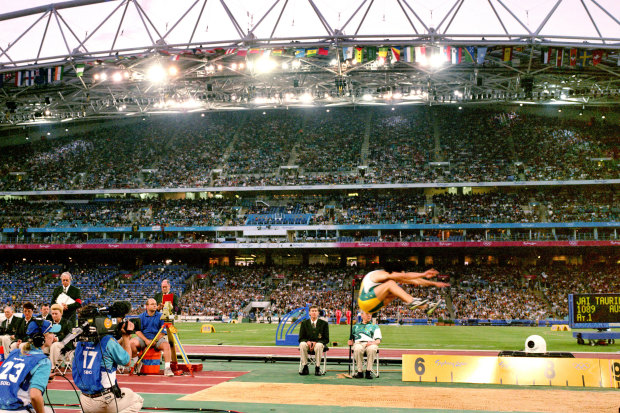
Jai Taurima competes in the long jump at the 2000 Olympics.Credit: Tim Clayton
Watching on television, I would have done anything to be there. Ian Thorpe and Cathy Freeman were national heroes at those Olympics, but Taurima was six centimetres away from being one, too. Pedroso’s final jump of 8.55 metres meant Taurima had to settle for silver.
Fun fact: Taurima’s mark would have won gold in four of the next five Olympic men’s long jump finals.
Tom Decent
Australia versus West Indies one-day international
Venue: SCG
Date and year: January 1, 1996
For cricket-loving Australian kids in the mid-1990s, at least the ones who stayed up late on New Year’s Day, this was the moment – an incredible finish at the end of a career-defining innings by one of the greats of the one-day game.
Looking back on it now from the Twenty20 era, the raw figures of Michael Bevan’s great escape against the West Indies seem unremarkable. A run chase of 172 hardly looks daunting. Even a match-winning four on the final ball is now commonplace – Glenn Maxwell won a game against India with four straight boundaries from the last four balls just last month, and it wasn’t even his best knock of the tour.
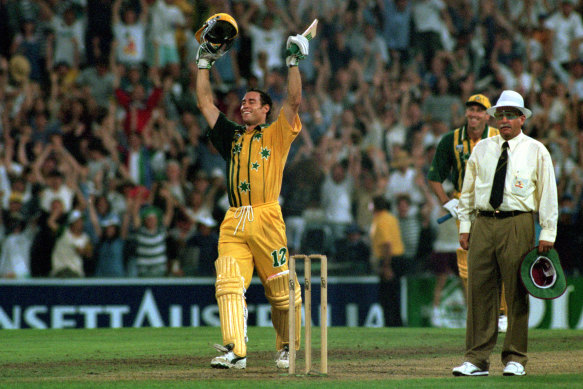
The moment that captivated: Michael Bevan celebrates his four off the last ball to take Australia to victory over the West Indies in an ODI at the SCG in 1996.Credit: Getty Images
But back then? Bevan’s unbeaten 78 was sublime, and perfectly paced as wickets tumbled around him.
Australia appeared done and dusted at 6-38 and were down to their final batsman (walking wicket Glenn McGrath) before Bevan lofted the ball over Roger Harper’s head for the winning runs.
It came at a time when every one-day international still felt like it mattered – this one, in the middle of a tri-series on New Year’s Day, drew a crowd of 37,500.
(Strangely enough, Bevan wasn’t named man of the match after his most famous knock. That honour went to paceman Paul Reiffel, with four wickets and 34 runs. Go figure.)
Dominic Brock
Australian Rugby League grand final
Venue: Sydney Football Stadium
When: September 28, 1997
The sports editor rightly asked: “Why would you have wanted to go to watch your team lose a grand final?”
A glutton for punishment, perhaps, but the 1997 ARL decider between my beloved Manly and Newcastle at the Sydney Football Stadium would have been one to behold (instead of watching it on one of the many TVs in the sound and vision section at the department store I worked during my uni days in the rugby league outpost that is Victoria, but that’s another story).
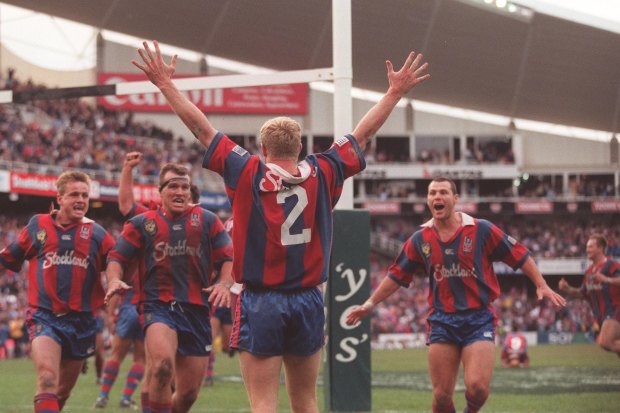
Iconic: Darren Albert scores for the Knights to win the 1997 grand final at the SFS.Credit: Adam Pretty
In the grip of the ARL-Super League war, this was the gladiatorial thriller the code had to have: Manly skipper Geoff Toovey being roughed up by the Knights but bouncing back time and again ... one of his manhandlers, Robbie O’Davis, crossing for a double ... Hoppa whopping it up after crossing first in the corner … another gripping instalment of Spudd versus Chief … and, finally, the brilliance of Andrew Johns to send Darren Albert over for the match-clinching try in the game’s dying seconds.
“Newcastle have won the grand final,” bellowed Channel Nine’s Ray Warren, to cap off “the game that saved rugby league”. Indeed, it was a gripping contest that had it all, except for a Sea Eagles win.
Jamie Berry
Carnival of the NSW Ladies Amateur Swimming Association
Venue: Municipal Baths, The Domain
When: February 23, 1913
Fanny Durack was already established as the world’s greatest female swimmer across all distances by the time this local event took place. She had nothing to prove. But this event was different. It was the first time women were allowed to compete in front of men.
The Sydney Morning Herald report of the carnival noted, “Being the first carnival of the Ladies’ Association to which males were admitted, the occasion was in the nature an experiment, and was successful from every standpoint”.
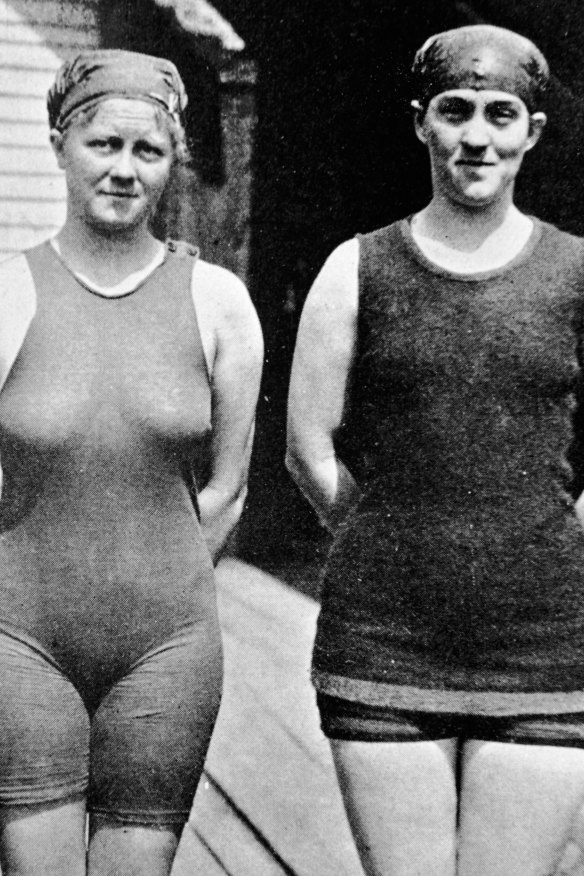
Mina Wylie and Fanny Durack at the 1912 Stockholm Olympics.Credit: Getty Images
“The management was excellent, the racing officials, all of whom were ladies, performing their duties capably, and without confusion. The general standard of the swimming was surprisingly good,” the report noted with a tone of surprise familiar to anyone at all interested in women’s sports.
Durack, the sixth child of Irish publicans, learnt to swim in the Coogee Baths and won her first state title in 1906 while still at school. Women were forbidden by the NSW Ladies Amateur Swimming Association from appearing in competitions when men were present, which meant she could not compete in the Olympics. But public pressure for Durack and her fellow competitor and great friend Mina Wylie to attend the 1912 Stockholm Games was so strong the club reversed its rule if the women paid their own way.
They did. Durack broke the world record for the 100 metres freestyle – the only individual event for women – in her heat before going on to win the gold medal, beating Wylie.
Put me in the stand that summer day more than a century ago to observe how much things have changed – and how much they have not.
Stephanie Peatling
Carbine versus Abercorn showdown, Autumn Racing Carnival
Venue: Randwick Racecourse
When: April 1889
As my infrequent donations to the bookies attest, I know very little about horse racing. But my family has a proud history in the sport, primarily through my great-grandfather Tom Payten, a leading Sydney trainer between 1880 and 1915.
Tom was the first Australian to train winners of 200 feature races, including Derbies, Oaks, St Legers, Australian Cups, Sydney Cups, Epsom Handicaps and the Caulfield Cup.
The best of all his thoroughbreds was a chestnut stallion called Abercorn, who enjoyed a fierce rivalry with the famous Carbine – and many believed was every bit as good as the horse people still cite as one of our best-ever, having won 33 of 43 starts. Phar Lap was a descendant of Carbine.
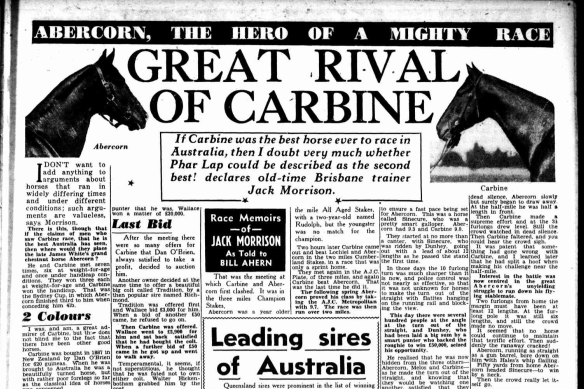
A Brisbane Telegraph article on the Abercorn v Carbine rivalryCredit: National Library of Australia
But Carbine had a serious competitor in the Randwick-trained Abercorn, who won 21 major races in Sydney and Melbourne. In a classic Melbourne-Sydney rivalry with firm camps of fans, the pair met six times in weight-for-age races across 1889 and 1890, and Abercorn beat Carbine in three of them.
Old Tom always maintained Abercorn was the better stayer and was dismayed when the horse was withdrawn by owners from the 1890 Melbourne Cup, due to a whopping 68kg handicap. He believed Abercorn, undefeated in six races that spring, would have downed Carbine (who won).
My magic ticket, then, would be to attend the Randwick Autumn Carnival in April 1889, when Abercorn and Carbine duelled in a staggering four races in four days.
Abercorn won the first and then the mighty Carbine won the next three. It would be a fascinating trip to take in the romance of old-style Sydney racing, and mostly to meet old Tom Payten, a giant of our family history. I’d show him a picture of his great-great-grandson, Tom Payten.
Iain Payten
England’s ‘Bodyline’ tour of Australia, first Test
Venue: Sydney Cricket Ground
When: December 2-7, 1932
Why choose a Test match during Bradman’s era in which The Don didn’t even play? Good question.
We all know tensions between Australia and England in that famous Bodyline series finally boiled over during the third Test in Adelaide, but I’ve always been more interested in: how did that series actually start?
Was it plain from the outset how Douglas Jardine and Harold Larwood would pepper Australia’s batters with short-pitch bowling and close-up catchers on the leg side? How did they handle it? Were the crowd up in arms from the opening session like they were later in the series? What did Bradman think of it all, missing the first Test because of a contract conflict with the board of control (although Jardine later accused him of having a nervous breakdown)?
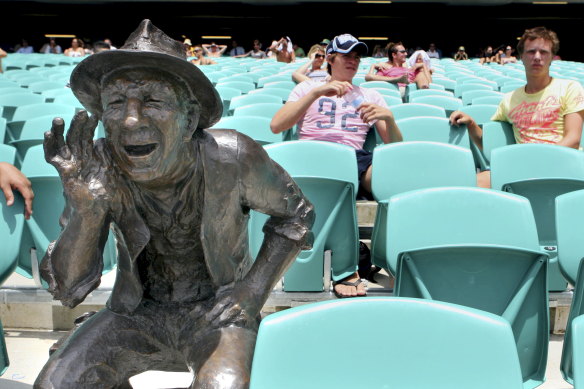
A monument to heckling: "Yabba" at the SCG.Credit: Dallas Kilponen
More importantly, could I have a beer in the outer with Yabba? “Leave our flies alone, Jardine. They’re the only friends you’ve got here.”
History judges one of the knocks in that series as good as most in Test cricket history. Stan McCabe belted an unbeaten 187 off 233 balls in Australia’s lone hand in the first innings, swatting balls rising sharply at his head and chest to the fence with ease.
And would anyone have easily noticed Nawab of Pataudi apparently refusing to take Jardine’s instruction to field in a Bodyline position? He was dropped for the next Test despite scoring a hundred.
England won easily – Larwood took 10 wickets for the match and the visitors only needed one ball in their second innings to score the solitary run needed to claim a 10-wicket victory.
That all seems a mere footnote. Did anyone really know what was about to come?
Adam Pengilly
Australia v Austria
Venue: Sydney Cricket Ground
When: 1958
My father, John Nicolussi, always used to always tell me about the day he played soccer in front of 30,000 fans at the SCG. A hard-running fullback whose Italian surname had most of his teammates bluffed he could actually play, Dad represented Lansvale United in a KO Cup game against Julia.
The roar of the crowd is something my dad will never forget, despite losing 3-1.
The game was played in 1957 as a curtain-raiser for the Australia versus Austria “second Test”, which the Austrians won 8-3.
Christian Nicolussi
Breaking of Evel Knievel’s world record
Venue: Newcastle Motordrome
When: May 28, 1978
For argument’s sake, accept the not-wholly-absurd proposition that Greater Newcastle is, really, just part of Sydney’s outer reach. Also consider this submission: causing motorbikes to be launched uncontrolled, off ramps and over vehicular conga lines is more a sport than an act of maddening death defiance.
In 1978, I was a portly three-year-old replete with Coke-bottle glasses. One of my most prized possessions was one of those wind-up Evel Knievel motorbike toys.

Dale Buggins leaps to a new world record.Credit: Fairfax Media
Evel Knievel, all hammered together with surgical pins and (in)famous for causing chaos and calamity more than anything else, never jumped a bike over anything in Australia. But by 1978, he held the world record for the greatest number of cars jumped over, on a motorbike.
On May 28, 1978, a scrawny 17-year-old Australian stuntman named Dale Buggins flew higher than birds soar at the Newcastle Motordrome, annihilating the world’s best mark that Evel previously achieved.
I saw Dale Buggins jump, once, after he broke that world record and not long before he died.
In absolute sincerity, he’s the first sporting hero I can recall having. I’ve thought about him, a great many times, in the 45 years that’ve since passed. I wish I’d seen his greatest jump.
Darren Kane
Read part one of our Magic Ticket series here.
The third and final part will be published on December 28.
Sports news, results and expert commentary. Sign up for our Sport newsletter.